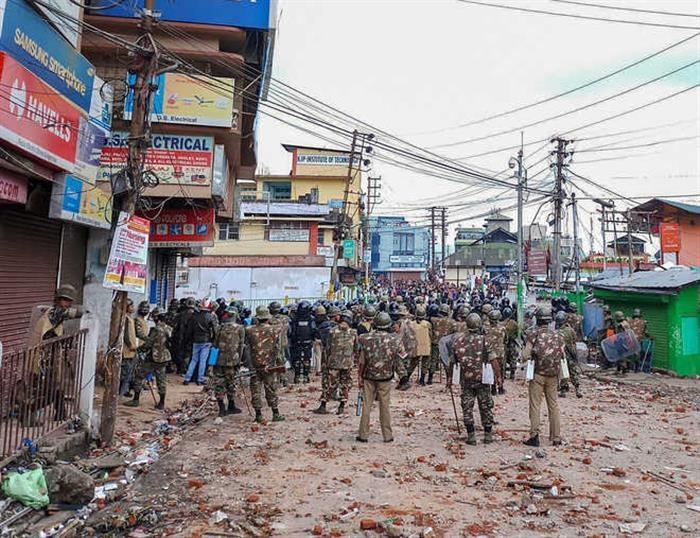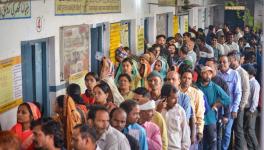Hindutva's Double Game in the Northeast

Image Coutesy: Punjab Newline
One aspect of the Shillong flare-up that should not be overlooked is the curious role of the Bharatiya Janata Yuva Morcha (BJYM). The BJYM has made statements supporting the relocation of the Punjabi Lane's residents. The lane is known to be a congested part of Shillong and is often referred to as a 'slum' or a 'ghetto'. The residents were brought there during colonial rule from Punjab to clean the dry latrines. The president of BJYM, Egenstar Kurkalang on Sunday stated that the Punjabi Lane is a commercial area in Khasi Hills and the state government should take a decision on shifting the residents to bring in peace and harmony. He also said that it is not the first time that the residents of Punjabi Lane showed their high handedness towards the tribals. This position of the BJYM is interesting on two counts, firstly that the morcha's parent party, the BJP is an alliance partner of the Shiromani Akali Dal (SAD). Secondly, the Hindutva ideology the party espouses does not go well with either Islam or Christianity, and the bulk of the tribal population in Meghalaya is Christian. What it lays bare is the duplicity of the BJYM and perhaps its parent party too.
The entire issue began over an altercation on Thursday which – with the help of social media – snowballed into a locals-versus-outsiders ethnic riot. Various pressure groups have called for the residents to be relocated, of which the BJYM is one of the voices in the bandwagon. The CM has alleged that the rioters are paid and have been brought in from outside Shillong. On the other hand, constant talk of resettlement instead of eviction does not give one the impression that the root cause is ethnic tension. It is ironic that the youth wing of a party which talks of 'national unity' and 'integrating the Northeast' has taken a such a stand.
Therefore, does the BJYM's stand reflects the BJP's own position vis a vis Sikhs? For one, the BJP is quick to rake up 1984 every time the Congress brings up 2002. The BJP is also aligned with the SAD, a party whose aim is to voice Sikh concerns and Sikh issues. Unless the BJYM is acting on its own, it appears that the BJP is insincere in either Punjab or in Meghalaya by aligning with majoritarian politics in both states.
The BJP during the recent assembly elections had fought hard to shed its Hindutva and anti-Christian image. However, the two candidates who won on the BJP tickets would have won regardless of which party ticket they contested on. In Hindu majority states in the Northeast, the Hindutva groups are capable of falling back on their old trick of using religion. Though at present it is likely to backfire in Assam, in Manipur it seems relatively muted, whereas in Tripura the CM seems intent on placing his foot in his mouth on a regular basis. In Arunachal Pradesh, there have been concerted efforts to Hinduise/Indianise the population. However, the situation appears to change in relation to the Christian majority states. This then brings to mind the question of how Hindutva affiliated groups operate in the Christian majority states in the Northeast.
Unlike Meghalaya, the BJP did better in Nagaland, yet here too, they relied on known faces jumping ship. The Hindutva activities in Naga inhabited areas date back to around 1978 when the VHP began working with the followers of Heraka. Heraka to its followers is the traditional religion of the Naga people and is derived from the traditional practices known as Paupaise. The religion which the Christian Nagas refer to as a 'cult' began with Jadonang and his niece, Gaidinliu. The two belonged to the Zeliangrong community and began their movement as one of cultural revivalism in the face of Christian missionaries 'destroying' Naga culture. Despite Jadonang's execution by the British colonial authorities for starting a 'cult' and Gaidinliu's incarceration for 'witchcraft', the belief system endured. Gaidinliu, once freed after independence, was used by Nehru to counter Phizo's 'Christian influenced' Naga nationalism.
The VHP and the RSS through their affiliated organisations began working with Heraka followers much later after the state of Nagaland was created. Their work focused on providing free school education for Heraka followers as well as paying for college tuition. They also distributed pamphlets featuring Hindu Gods and Goddesses as well as religious symbols such as Om and the Swastika. Many Heraka followers see this as assistance to a discriminated minority in Nagaland. The Christian Nagas, however, see the Heraka followers as Hindus. Thus, the proponents of Hindutva have gained visibility in a Christian majority state on the basis of an existing wedge. Further, the narrative propounded by Ghurye that tribals are just backward Hindus has been used to establish the Hindu link with the Heraka followers.
The other Christian majority state, Mizoram, also presents an interesting comparison. The Zo people are the majority population and are mostly Christian. However, within the boundaries of the state exist two minority tribal groups, the Chakma and the Bru or Reang. Both of whom are not Christian. The Chakmas are predominantly Buddhist and though they face a degree of discrimination in terms of their autonomous councils have not been displaced by the majority community. The Bru, on the other hand, have faced violence, and many are languishing as refugees in Tripura since the tensions began in 1997. The Bru are animists and perhaps, as a political strategy, have reached out to the Hindutva organisations. The aim of the Brus is to be repatriated in Mizoram, whereas the majority of Mizos do not want their return. The Bru Hindu Joint Coordination Committee reportedly has in the past written to MHA requesting the ministry to safeguard the Hindu religion or the indigenous faith of the Bru people in Mizoram. The Vanvasi Kalyan Ashram is active among the Bru refugees in Tripura, and attempts have been made to connect the Brus with the larger Hindu mythology. It is unlikely that this would give the BJP a platform in Mizoram, however, December is still a few months away.
Therefore, the BJP and its youth wing both appear to align with majoritarian tribal interests for political gains in the Christian majority states. At the same time, their ideological affiliates seem to exploit existing fissures, particularly when it is a question of an animist or shamanist belief system versus Christianity. The current situation in Shillong echoes this strategy, where the BJYM has voiced support for relocating the residents of Punjabi Lane. The state government, on the other hand, has not bowed to public pressure and started relocating the residents as a knee-jerk exercise. Instead, they have constituted a committee to study the issues and provide recommendations for a course of action that may include relocating the residents.
Get the latest reports & analysis with people's perspective on Protests, movements & deep analytical videos, discussions of the current affairs in your Telegram app. Subscribe to NewsClick's Telegram channel & get Real-Time updates on stories, as they get published on our website.
























